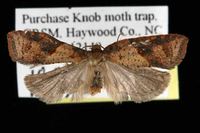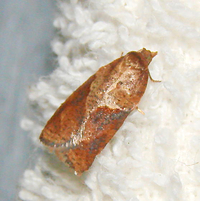Taxonomy
Superfamily:
Family: Subfamily: Tribe: P3 Number: MONA Number:
Comments: Acleris maccana occurs in North American and Eurasia, and BOLD sequencing data indicate that specimens from North America (Canada and the United States) and Europe (Austria, Czech Republic, Finland, Norway) constitute a single, holarctic species (Gilligan et al., 2020).
Identification
Adult Markings: Acleris maccana varies substantially in its dorsal patterning, with specimens commonly having a narrow, oblique band that helps to cleanly separate a predominantly light gray or otherwise lighter region before the band from a predominantly darker region posteriorly. The palps, head and thorax vary from light rusty red to light rusty brown or tan. The thorax has a thin, incurved dark-brown line anteriorly and tends to be lighter near the posterior tip.
Adult Structural Features: MPG has an image of the male genitalia. Also, see image below.
Adult ID Requirements: Identifiable only by close inspection of structural features or by DNA analysis.
Immatures and Development: The larvae are solitary feeders that fold or tie the leaves of deciduous shrubs and trees, but details of the life history are largely undocumented. Local populations produce a single brood, with the adults emerging in Canada from late-August through October. They appear to overwinter before becoming active again with the spring warm-up (University of Alberta E.H. Strickland Entomological Museum).
Larvae ID Requirements: Identifiable only through rearing to adulthood.
Distribution in North Carolina
Distribution: Acleris maccana is found in both eastern and western North America in areas with cool climates. Populations in the West have been found in northern California, Oregon, Washington, Montana, Alaska, the Yukon, the Northwest Territories, British Columbia, Alberta, and Saskatchewan. In the East, it occurs in southern Canada (Ontario; Quebec; Newfoundland; New Brunswick; Nova Scotia) and in the U.S. from Wisconsin and Michigan eastward to the New England states, and southward along the Appalachian region to Tennessee and North Carolina. As of 2024, all of our records are from middle to higher-elevation sites in the Blue Ridge. County Map: Clicking on a county returns the records for the species in that county.
Flight Dates: Click on graph to enlarge
Flight Comments: The adults have been observed during every month of the year in different areas of the range, with many populations appearing to have one generation per year. As of 2024, our very limited records are from mid-May and October.
Habitats and Life History
Habitats: This species is generally associated with boreal forests and forest openings, including bog habitats. Our few records as of 2024 are from middle to higher-elevations sites, and typically with hardwood forest and associated forest openings. Larval Host Plants: The larvae are polyphagous and feed mostly on deciduous shrubs and trees (McDunnough 1934; Meyrick, 1938; Bradley et al., 1973; MacKay, 1962a; Prentice 1966; Emmet, 1992; Spitzer et al. 2003; Brown et al., 2008; Robinson et al., 2010; Wheatall et al., 2013). The reported hosts include Gray Alder (Alnus incana ), Red Alder (A. rubra ), Sweet Birch (Betula lenta ), Paper Birch (B. papyrifera ), Rhododendron , European Blueberry (Vaccinium myrtillus ), Bog Blueberry (V. uliginosum ), Lingonberry (V. vitis-idaea ), a gooseberry (Ribes sp.), Sweet-gale (Myrica gale ), apples (Malus ), Quaking Aspen (Populus tremuloides ), Cutleaf Blackberry (Rubus lasciniatus ), and a willow (Salix sp.). As of 2024, we do not have any feeding records for North Carolina. - View Observation Methods: The adults are attracted to lights.Wikipedia
Status in North Carolina
Natural Heritage Program Status: Natural Heritage Program Ranks: GNR[S2S3]State Protection: Has no legal protection, although permits are required to collect it on state parks and other public lands. Comments: This mostly circumboreal species reaches its southernmost limits in the southern Appalachians in eastern Tennessee and western North Carolina where it appears to be rare. More information is needed on its hosts, distribution and abundance before we can accurately assess is conservation status within North Carolina.

 »
»


 »
»
